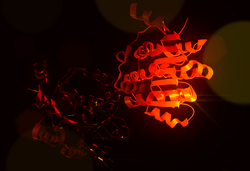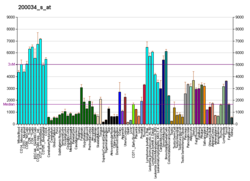Protein-coding gene in Homo sapiens
Probable ATP-dependent RNA helicase DDX5 also known as DEAD box protein 5 or RNA helicase p68 is an enzyme that in humans is encoded by the DDX5 gene .[ 5]
Function
DEAD box proteins, characterized by the conserved motif Asp -Glu -Ala -Asp (DEAD), are putative RNA helicases . They are implicated in a number of cellular processes involving alteration of RNA secondary structure , such as translation initiation , nuclear and mitochondrial splicing , and ribosome and spliceosome assembly. Based on their distribution patterns, some members of this family are believed to be involved in embryogenesis , spermatogenesis ,[ 6] cellular growth and division. This gene encodes a DEAD box protein, which is an RNA-dependent ATPase, and also a proliferation-associated nuclear antigen, specifically reacting with the simian virus 40 tumor antigen . This gene consists of 13 exons , and alternatively spliced transcripts containing several intron sequences have been detected, but no isoforms encoded by these transcripts have been identified.[ 5]
Interactions
DDX5 has been shown to interact with:
References
^ a b c GRCh38: Ensembl release 89: ENSG00000108654 – Ensembl , May 2017^ a b c GRCm38: Ensembl release 89: ENSMUSG00000020719 – Ensembl , May 2017^ "Human PubMed Reference:" . National Center for Biotechnology Information, U.S. National Library of Medicine .^ "Mouse PubMed Reference:" . National Center for Biotechnology Information, U.S. National Library of Medicine .^ a b "Entrez Gene: DDX5 DEAD (Asp-Glu-Ala-Asp) box polypeptide 5" .^ Legrand J, Chan AL, La HM, Rossello FJ, Änkö ML, Fuller-Pace FV, Hobbs RM (23 May 2019). "DDX5 plays essential transcriptional and post-transcriptional roles in the maintenance and function of spermatogonia" . Nature Communications . 10 (1): 2278. Bibcode :2019NatCo..10.2278L . doi :10.1038/s41467-019-09972-7 . PMC 6533336 PMID 31123254 . ^ Akileswaran L, Taraska JW, Sayer JA, Gettemy JM, Coghlan VM (May 2001). "A-kinase-anchoring protein AKAP95 is targeted to the nuclear matrix and associates with p68 RNA helicase" . J. Biol. Chem . 276 (20): 17448– 54. doi :10.1074/jbc.M101171200 PMID 11279182 . ^ Ogilvie VC, Wilson BJ, Nicol SM, Morrice NA, Saunders LR, Barber GN, Fuller-Pace FV (March 2003). "The highly related DEAD box RNA helicases p68 and p72 exist as heterodimers in cells" . Nucleic Acids Res . 31 (5): 1470– 80. doi :10.1093/nar/gkg236 . PMC 149829 PMID 12595555 . ^ Wilson BJ, Giguère V (2007). "Identification of novel pathway partners of p68 and p72 RNA helicases through Oncomine meta-analysis" . BMC Genomics . 8 : 419. doi :10.1186/1471-2164-8-419 PMC 3225811 PMID 18005418 . ^ Rossow KL, Janknecht R (January 2003). "Synergism between p68 RNA helicase and the transcriptional coactivators CBP and p300" . Oncogene . 22 (1): 151– 6. doi :10.1038/sj.onc.1206067 PMID 12527917 . ^ Nicol SM, Causevic M, Prescott AR, Fuller-Pace FV (June 2000). "The nuclear DEAD box RNA helicase p68 interacts with the nucleolar protein fibrillarin and colocalizes specifically in nascent nucleoli during telophase". Exp. Cell Res . 257 (2): 272– 80. doi :10.1006/excr.2000.4886 . PMID 10837141 . ^ Wilson BJ, Bates GJ, Nicol SM, Gregory DJ, Perkins ND, Fuller-Pace FV (August 2004). "The p68 and p72 DEAD box RNA helicases interact with HDAC1 and repress transcription in a promoter-specific manner" . BMC Mol. Biol . 5 : 11. doi :10.1186/1471-2199-5-11 PMC 514542 PMID 15298701 . ^ Bates GJ, Nicol SM, Wilson BJ, Jacobs AM, Bourdon JC, Wardrop J, Gregory DJ, Lane DP, Perkins ND, Fuller-Pace FV (February 2005). "The DEAD box protein p68: a novel transcriptional coactivator of the p53 tumour suppressor" . EMBO J . 24 (3): 543– 53. doi :10.1038/sj.emboj.7600550 . PMC 548656 PMID 15660129 . ^ Yao H, Brick K, Evrard Y, Xiao T, Camerini-Otero RD, Felsenfeld G (2010). "Mediation of CTCF transcriptional insulation by DEAD-box RNA-binding protein p68 and steroid receptor RNA activator SRA" . Genes Dev . 24 (22): 2543– 2555. doi :10.1101/gad.1967810 . PMC 2975930 PMID 20966046 .
Further reading
Iggo RD, Jamieson DJ, MacNeill SA, et al. (1991). "p68 RNA helicase: identification of a nucleolar form and cloning of related genes containing a conserved intron in yeasts" . Mol. Cell. Biol . 11 (3): 1326– 33. doi :10.1128/MCB.11.3.1326 . PMC 369403 PMID 1996094 . Hloch P, Schiedner G, Stahl H (1990). "Complete cDNA sequence of the human p68 protein" . Nucleic Acids Res . 18 (10): 3045. doi :10.1093/nar/18.10.3045 . PMC 330836 PMID 2349099 . Ford MJ, Anton IA, Lane DP (1988). "Nuclear protein with sequence homology to translation initiation factor eIF-4A". Nature . 332 (6166): 736– 8. Bibcode :1988Natur.332..736F . doi :10.1038/332736a0 . PMID 2451786 . S2CID 4351448 . Iggo R, Gough A, Xu W, et al. (1989). "Chromosome mapping of the human gene encoding the 68-kDa nuclear antigen (p68) by using the polymerase chain reaction" . Proc. Natl. Acad. Sci. U.S.A . 86 (16): 6211– 4. Bibcode :1989PNAS...86.6211I . doi :10.1073/pnas.86.16.6211 PMC 297807 PMID 2762324 . Buelt MK, Glidden BJ, Storm DR (1994). "Regulation of p68 RNA helicase by calmodulin and protein kinase C" . J. Biol. Chem . 269 (47): 29367– 70. doi :10.1016/S0021-9258(18)43885-9 PMID 7525583 . Brody LC, Abel KJ, Castilla LH, et al. (1995). "Construction of a transcription map surrounding the BRCA1 locus of human chromosome 17" . Genomics . 25 (1): 238– 47. doi :10.1016/0888-7543(95)80131-5 PMID 7774924 . Rössler OG, Hloch P, Schütz N, et al. (2000). "Structure and expression of the human p68 RNA helicase gene" . Nucleic Acids Res . 28 (4): 932– 9. doi :10.1093/nar/28.4.932 . PMC 102575 PMID 10648785 . Nicol SM, Causevic M, Prescott AR, Fuller-Pace FV (2000). "The nuclear DEAD box RNA helicase p68 interacts with the nucleolar protein fibrillarin and colocalizes specifically in nascent nucleoli during telophase". Exp. Cell Res . 257 (2): 272– 80. doi :10.1006/excr.2000.4886 . PMID 10837141 . Akileswaran L, Taraska JW, Sayer JA, et al. (2001). "A-kinase-anchoring protein AKAP95 is targeted to the nuclear matrix and associates with p68 RNA helicase" . J. Biol. Chem . 276 (20): 17448– 54. doi :10.1074/jbc.M101171200 PMID 11279182 . Andersen JS, Lyon CE, Fox AH, et al. (2002). "Directed proteomic analysis of the human nucleolus" . Curr. Biol . 12 (1): 1– 11. Bibcode :2002CBio...12....1A . doi :10.1016/S0960-9822(01)00650-9 PMID 11790298 . S2CID 14132033 . Jurica MS, Licklider LJ, Gygi SR, et al. (2002). "Purification and characterization of native spliceosomes suitable for three-dimensional structural analysis" . RNA . 8 (4): 426– 39. doi :10.1017/S1355838202021088 . PMC 1370266 PMID 11991638 . Liu ZR (2002). "p68 RNA Helicase Is an Essential Human Splicing Factor That Acts at the U1 snRNA-5′ Splice Site Duplex" . Mol. Cell. Biol . 22 (15): 5443– 50. doi :10.1128/MCB.22.15.5443-5450.2002 . PMC 133941 PMID 12101238 . Strausberg RL, Feingold EA, Grouse LH, et al. (2003). "Generation and initial analysis of more than 15,000 full-length human and mouse cDNA sequences" . Proc. Natl. Acad. Sci. U.S.A . 99 (26): 16899– 903. Bibcode :2002PNAS...9916899M . doi :10.1073/pnas.242603899 PMC 139241 PMID 12477932 . Rossow KL, Janknecht R (2003). "Synergism between p68 RNA helicase and the transcriptional coactivators CBP and p300" . Oncogene . 22 (1): 151– 6. doi :10.1038/sj.onc.1206067 PMID 12527917 . Guil S, Gattoni R, Carrascal M, et al. (2003). "Roles of hnRNP A1, SR Proteins, and p68 Helicase in c-H-ras Alternative Splicing Regulation" . Mol. Cell. Biol . 23 (8): 2927– 41. doi :10.1128/MCB.23.8.2927-2941.2003 . PMC 152554 PMID 12665590 . Fujita T, Kobayashi Y, Wada O, et al. (2003). "Full activation of estrogen receptor alpha activation function-1 induces proliferation of breast cancer cells" . J. Biol. Chem . 278 (29): 26704– 14. doi :10.1074/jbc.M301031200 PMID 12738788 . Ota T, Suzuki Y, Nishikawa T, et al. (2004). "Complete sequencing and characterization of 21,243 full-length human cDNAs" . Nat. Genet . 36 (1): 40– 5. doi :10.1038/ng1285 PMID 14702039 .
Activity Regulation Classification Kinetics Types


 Read
Read
 AUTHORPÆDIA is hosted by Authorpædia Foundation, Inc. a U.S. non-profit organization.
AUTHORPÆDIA is hosted by Authorpædia Foundation, Inc. a U.S. non-profit organization.





